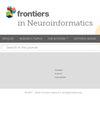通过海马体中心建立海马体神经元模型的在线互操作资源
IF 2.5
4区 医学
Q2 MATHEMATICAL & COMPUTATIONAL BIOLOGY
引用次数: 0
摘要
为了建立大脑细胞、电路和区域的生物物理详细模型,越来越多地采用数据驱动的方法。这有助于获得模拟活动,尽可能忠实地再现实验记录的神经动力学,并将模型转化为基于控制神经细胞本质的原则进行预测的有用框架。在这样的背景下,对现有神经模型和数据的访问极大地促进了计算神经科学家的工作,并促进了其新颖性,因为科学界的发展越来越广泛,神经模型的类型、大小和数量也在逐步增加。然而,即使在可访问性得到保证的情况下,数据和模型也很少被重用,因为很难检索、提取和/或理解相关信息,科学家经常需要下载和修改单个文件,执行神经数据分析,优化模型参数,并使用自己的资源运行模拟。在专注于海马体细胞的生物物理和形态学精确模型的构建时,我们创建了一个在线资源,即海马体中心的构建部分-海马体研究的科学门户-从不同的在线开放存储库收集数据和模型,并允许将其收集作为单细胞模型构建工作流程的第一步。工具和数据的互操作性是我们正在介绍的工作的关键特征。通过一个简单的点击收集程序,就像填充网上商店的购物车一样,研究人员可以直观地选择感兴趣的文件(即电生理记录、神经形态学和模型组件),并开始构建数据驱动的海马神经元模型。这样的工作流程重要地包括一个模型优化过程,它利用透明地授予用户的高性能计算资源,以及一个用于运行优化模型模拟的框架,两者都可以通过EBRAINS Hodgkin-Huxley Neuron Builder在线工具获得。本文章由计算机程序翻译,如有差异,请以英文原文为准。
Online interoperable resources for building hippocampal neuron models via the Hippocampus Hub
To build biophysically detailed models of brain cells, circuits, and regions, a data-driven approach is increasingly being adopted. This helps to obtain a simulated activity that reproduces the experimentally recorded neural dynamics as faithfully as possible, and to turn the model into a useful framework for making predictions based on the principles governing the nature of neural cells. In such a context, the access to existing neural models and data outstandingly facilitates the work of computational neuroscientists and fosters its novelty, as the scientific community grows wider and neural models progressively increase in type, size, and number. Nonetheless, even when accessibility is guaranteed, data and models are rarely reused since it is difficult to retrieve, extract and/or understand relevant information and scientists are often required to download and modify individual files, perform neural data analysis, optimize model parameters, and run simulations, on their own and with their own resources. While focusing on the construction of biophysically and morphologically accurate models of hippocampal cells, we have created an online resource, the Build section of the Hippocampus Hub -a scientific portal for research on the hippocampus- that gathers data and models from different online open repositories and allows their collection as the first step of a single cell model building workflow. Interoperability of tools and data is the key feature of the work we are presenting. Through a simple click-and-collect procedure, like filling the shopping cart of an online store, researchers can intuitively select the files of interest (i.e., electrophysiological recordings, neural morphology, and model components), and get started with the construction of a data-driven hippocampal neuron model. Such a workflow importantly includes a model optimization process, which leverages high performance computing resources transparently granted to the users, and a framework for running simulations of the optimized model, both available through the EBRAINS Hodgkin-Huxley Neuron Builder online tool.
求助全文
通过发布文献求助,成功后即可免费获取论文全文。
去求助
来源期刊

Frontiers in Neuroinformatics
MATHEMATICAL & COMPUTATIONAL BIOLOGY-NEUROSCIENCES
CiteScore
4.80
自引率
5.70%
发文量
132
审稿时长
14 weeks
期刊介绍:
Frontiers in Neuroinformatics publishes rigorously peer-reviewed research on the development and implementation of numerical/computational models and analytical tools used to share, integrate and analyze experimental data and advance theories of the nervous system functions. Specialty Chief Editors Jan G. Bjaalie at the University of Oslo and Sean L. Hill at the École Polytechnique Fédérale de Lausanne are supported by an outstanding Editorial Board of international experts. This multidisciplinary open-access journal is at the forefront of disseminating and communicating scientific knowledge and impactful discoveries to researchers, academics and the public worldwide.
Neuroscience is being propelled into the information age as the volume of information explodes, demanding organization and synthesis. Novel synthesis approaches are opening up a new dimension for the exploration of the components of brain elements and systems and the vast number of variables that underlie their functions. Neural data is highly heterogeneous with complex inter-relations across multiple levels, driving the need for innovative organizing and synthesizing approaches from genes to cognition, and covering a range of species and disease states.
Frontiers in Neuroinformatics therefore welcomes submissions on existing neuroscience databases, development of data and knowledge bases for all levels of neuroscience, applications and technologies that can facilitate data sharing (interoperability, formats, terminologies, and ontologies), and novel tools for data acquisition, analyses, visualization, and dissemination of nervous system data. Our journal welcomes submissions on new tools (software and hardware) that support brain modeling, and the merging of neuroscience databases with brain models used for simulation and visualization.
 求助内容:
求助内容: 应助结果提醒方式:
应助结果提醒方式:


